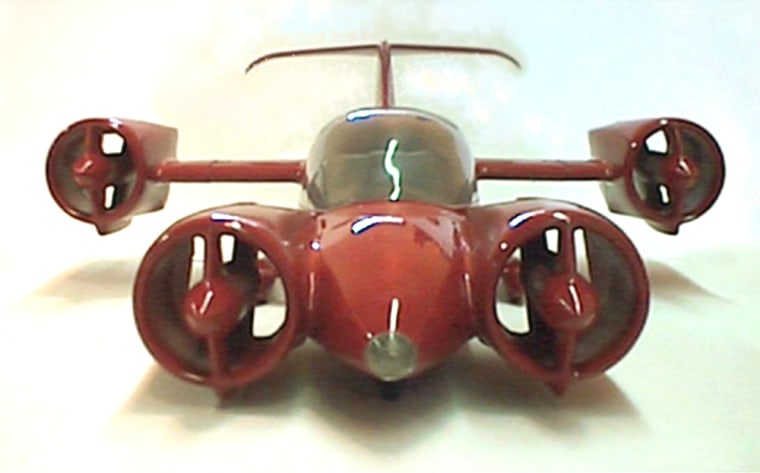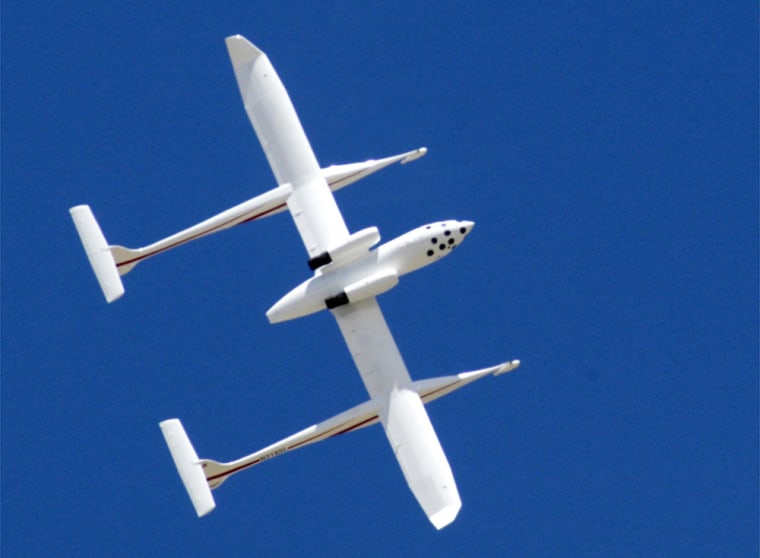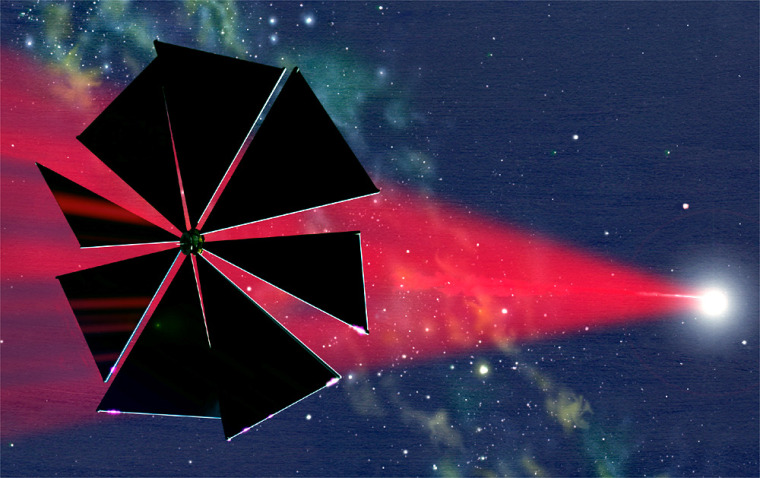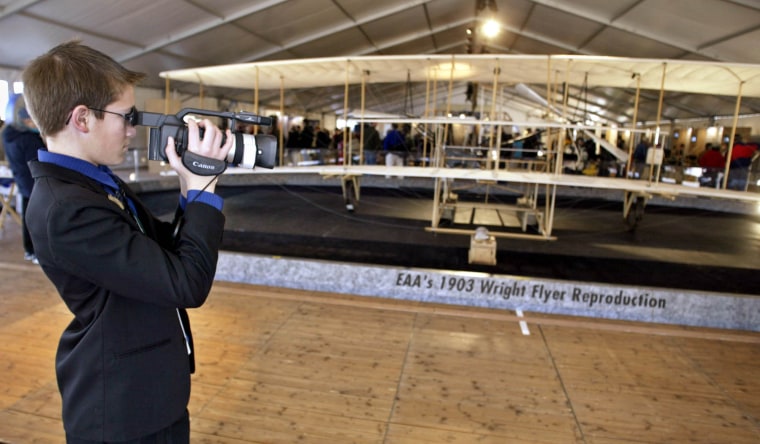When the Wright brothers were in their teens, they were already dreaming of taking flight. So what are tomorrow's Wright brothers dreaming of? Some want to make personal aviation more affordable. Others are working on ways to go farther and faster. For Keith Yoerg, the 13-year-old great-great-grandnephew of Orville and Wilbur, the dream comes down to one word: Mars.
Exactly 100 years ago on Wednesday, the Wright brothers turned their dream into reality over the sands of the North Carolina coast, near Kitty Hawk. Inspired, Yoerg has set his sights on getting his pilot's license, becoming an astronaut — and eventually extending the legacy of the Wright brothers by setting foot on the Red Planet.
"That'd be a great place to go," he told MSNBC.com. "It must be a lot like Kitty Hawk was in 1903. Desert and sandy, from the pictures that I've seen. It would be a bridge from the past to the future. It would almost be a modern re-enactment of what they did."
Yoerg isn't the only one seeking to build on the legacy of his famous forebears: Thousands of scientists and engineers, explorers and tinkerers are expanding on Orville and Wilbur's dreams of flight, spiritual heirs if not blood relatives. Based on suggestions from MSNBC.com users, we've put together an initial list of innovators who just might inspire future generations the way the Wrights have inspired Yoerg:
Powered flight to the people

The idea of putting an airplane in every garage is one of the great unfulfilled dreams of general aviation. But several entrepreneurs are working to develop safer, more efficient, more affordable and easier-to-use airplanes. Such vehicles could open the way for air-taxi services, revive the nation's smaller airports and relieve the congestion at the larger ones:
- His Skycar is a sentimental favorite for flying-car fans, and he's planning a major demonstration flight next spring. But the first commercially viable fruits of his 40-year quest likely will have more to do with his patented rotary engine design. "I'm not going to be a Ford or a GM," he told MSNBC.com. "I'm just having a good time and sometimes a scary time breaking through new technologies."
- The chief executive officer and president of Eclipse Aviation says the company is on track to bring its low-cost, high-tech jets to market in 2006. He sees some parallels to the pioneering days of aviation. "What we're doing with the Eclipse is in essence rejection of the conventional wisdom. And the Wrights did exactly that," he said. But there are differences as well: "The challenges today are significantly greater in terms of technology, the business climate, the regulatory climate and involving capital."
- Cirrus Design's co-founder and president also has a vision of bringing down the cost of personal flying. He's also part of a brother act; Dale Klapmeier is Cirrus' vice president. The single-engine Cirrus is equipped with a parachute landing system as an extra safety measure. But the selling points focus on user-friendliness and economy as well as safety. "We think of it as consumer-driven aviation," he said. "We're never going to have the airplane in every garage, but we will make air transportation more commonplace, because people will be able to afford it."
- His team in Worcester, Mass., is developing an electric-powered, fuel-cell-equipped airplane that could eventually have a range of 500 miles. The first test flight of the "E-Plane" could come early next year — and the revolutionary fuel-cell concept has attracted interest from the Boeing Co. as well.
Private-enterprise space race

In the four decades since humans first went into outer space, less than 500 people have made the 100-kilometer-high trip. Spurred on in part by the $10 million X Prize, a league of designers and entrepreneurs are developing new spacecraft or striking new deals to bring down launch costs and bring up more space passengers.
- The man who designed the round-the-world Voyager airplane is targeting suborbital spaceflight with his White Knight / SpaceShipOne combination. In a PBS interview, Rutan said he took his inspiration from the pioneers of aviation: "A lot of them crashed. A lot of them didn't even get off the ground. By natural selection the airplane was developed, and most of it was nonsense, but the ones that became breakthroughs are the airplanes of today."
- The head of Armadillo Aerospace, who made millions as a game developer, is considered Rutan's closest competition. "Rocket science has this mystique and mythology about it, but it's completely out of proportion with its level of difficulty," he told the Dallas Business Journal. "A computer is radically more advanced than a rocket ship."
- PayPal's founder has similarly put his fortune into spaceflight — but he is developing a new satellite launch vehicle rather than a suborbital passenger craft. In his view, cheaper access to orbit is the key to reigniting interest in space travel. "I think there's quite a bit of will," he said at this year's Mars Society convention. "It's not so much 'Where there's a will, there's a way.' I think it's 'Where there's a way, there's a will.'"
- XCOR Aerospace's chief executive officer isn't going after the X Prize, but his company is seeking a commercial launch license from the Federal Aviation Administration for a reusable, suborbital spaceship that could give the X Prize competitors a run for their money. "We're not in a rush to be the first to do it; we want to be the first to make real money doing it," he told The New York Times.
- His company, Space Adventures, brokered the deals that sent the international space station its first paying passengers: California millionaire Dennis Tito in 2001, and South African millionaire Mark Shuttleworth in 2002. On Tuesday, he announced that had signed contracts for space station trips. "It's testament to the fact that spaceflight and space exploration are going to be the biggest part of the next 100 years of flight," Anderson told MSNBC.com.
Flying like never before

A little more than 100 years ago, powered heavier-than-air flight seemed so difficult that Wilbur Wright himself predicted "man would not fly for 50 years." Similarly, some visionaries are pressing forward today with flight concepts that skeptics might dismiss as pure science fiction: interplanetary solar sailing, stronger-than-steel space elevators and plasma-powered space cruisers.
- Carl Sagan's widow is keeping the late astronomer's "Cosmos" flame alive, not only by presiding over Cosmos Studios, but also by supporting such projects as the Cosmos 1 solar sail and the SETI alien-seeking computing grid in cooperation with the Planetary Society. The solar sail is due to fly in space next year, and Druyan says the challenges remind her of the Wrights' experience: "I think of their four failed businesses. I think that, in the classic American tradition, they were essentially nobodies, with no one to pave the way for them. ... Obviously the possibility of failure is always a reality, but that tiny hope that we might succeed, and our descendants in the exploration game might look back on us, and thank us, and remember us with respect, is definitely one of the things that keep me going."
- The physicist helped bring Arthur C. Clarke's concept of a space elevator close enough to reality that researchers now believe they can actually build the darn thing: It would be a carbon-nanotube ribbon stretching out 62,000 miles (100,000 kilometers) from Earth's surface, on which payloads of up to 5 tons could ride into orbit. "This is a different technology than rockets," Edwards told Space.com. “Whether you’re going into Earth orbit, to the moon, Mars, Venus, the asteroids ... the space elevator is really the way to go."
- Along with fellow astronaut Jerry Ross, Chang-Diaz holds the record for most space shuttle missions flown (seven) — but spaceflight is just one side of the story. The physicist/spacewalker is also director of the Advanced Space Propulsion Laboratory at NASA's Johnson Space Center, focusing on the development of plasma power for future interplanetary missions. "Nuclear power is definitely a must if we're going to go to Mars," Chang-Diaz said in a NASA report on his research. That fits in with NASA's Project Prometheus — and someday the technology just might make young Yoerg's dream come true.
